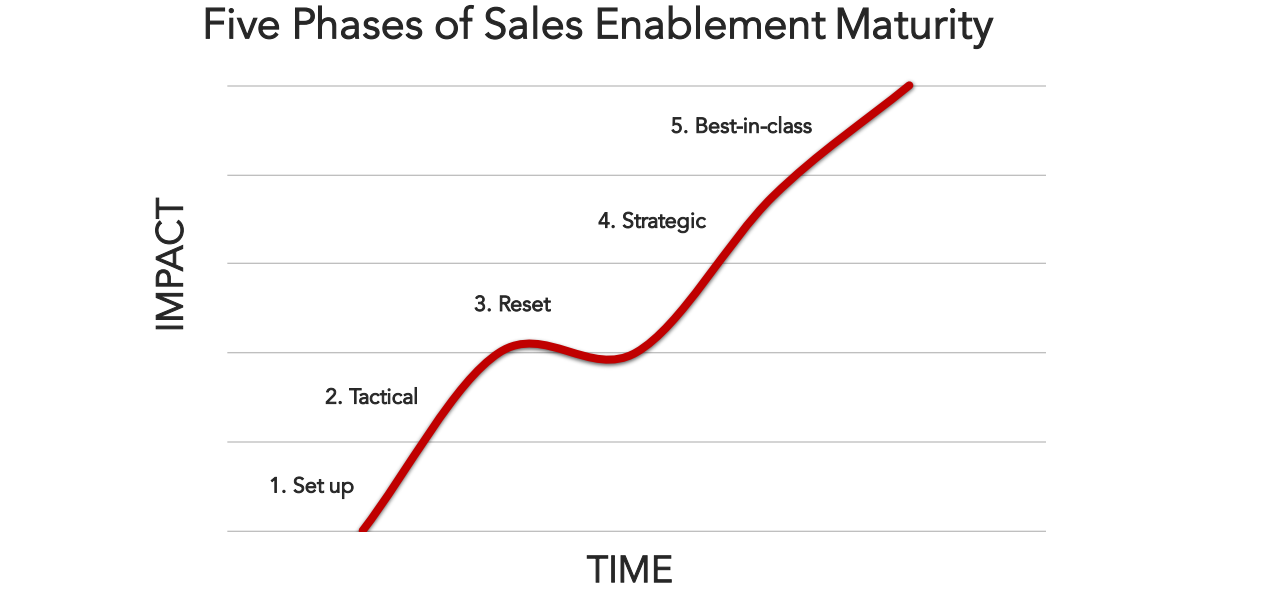Sales enablement is a rapidly emerging, but immature function. Many companies are investing in the creation of sales enablement teams, but as they’re so new, there’s a distinct lack of thought leadership, standardised measurement and best practices available.
Subsequently, people often (and understandably) struggle to fully grasp the function. This fuels ambiguity about what sales enablement is and the value it creates for a business. This can, must and will change.
To discover how others are thinking about this challenge I met with a bunch of sales enablement colleagues I admire at Facebook, LinkedIn, Stripe, Dropbox, AdRoll, Intercom and Procore. All the discussions were uniquely insightful, but some patterns emerged based on how long the respective sales enablement teams had been operational.
From these meetings it became clear to me that there are various phases of sales enablement maturity and each stage has distinct characteristics. Put simply, as a sales organisation grows, the sales enablement team must evolve alongside it. But before we cover the various phases of sales enablement maturity, let’s look at what sales enablement is.
Defining sales enablement
How we define sales enablement matters. A lot. My colleagues and I at HubSpot spent considerable time crafting the following definition of sales enablement:
“Sales enablement is a strategic discipline that partners cross-functionally to help the sales organisation succeed. We are advocates of sales reps and support them by providing content, deal support, training, best practices, knowledge, tools and technology throughout the sales process.”
The definition is not 100% perfect, but we’re okay with that. It will inevitably evolve over time, but it offers clarity and importantly, answers the basics of who we are as a sales enablement team, what we do and how we do it. The definition is the foundation on which the team is built, but it’s the plays and tactics which drive results, gain attention and get measured.
At HubSpot I invest my time in the following plays and tactics:
Sales training - product, sales technique and competitor training
Deal support - deal strategy, competitive intelligence and customer reference calls
Sales projects - sales rep productivity and sales and marketing alignment
Sales content - sales collateral, demo deck and case studies
Before we cover the varying stages of sales enablement maturity, I’ll share two important caveats. For the most part, companies with mature and sophisticated sales enablement functions have more sales reps. This makes sense - as increasing numbers of sales reps are hired, complexity creeps in and a more mature approach to sales enablement is required. Secondly, becoming best-in-class is tough - really tough, and the reality is most organisations won’t make it to this level of maturity. In fact, many will remain tactical order takers, rather than progressing to the status of a trusted, strategic partner.
Sales Enablement Maturity
Based on discussions with leading companies and my own analysis, here are the five phases of sales enablement maturity:
1. Set up
Rather than being purposefully set up, most sales enablement functions evolve over time. Prior to the formation of a sales enablement team there’s often a person who takes on sales enablement responsibilities, such as sales content, onboarding and training. In many cases these responsibilities are performed in an informal capacity - the person appreciates this work needs to be done and they have a GSD AKA “get shit done” mentality, so they just do it.
At this point sales enablement is really scrappy and that’s fine - the sales organisation needs support and somebody provides it. Oftentimes, the person who steps forward is doing this in addition to another role at the company, but they’ve identified an area where they can make a big impact. After some initial success, businesses come to realise the value created by sales enablement and that they need to make it somebody’s responsibility full time. The usual playbook is to then appoint or promote the person who has been undertaking the sales enablement activities, rather than hire someone from outside the company.
Companies at the set up stage have little or no data to benchmark sales enablement activity and often gauge success in terms of deliverables, such as creating an onboarding program, rather than improving key sales metrics like demo to close rate. Sales enablement measurement is challenging, but it’s all about execution and delivery at this phase. Iteration and improvement can come once the foundations are in place.
2. Tactical
Once someone is made responsible for sales enablement and given dedicated resources to build out a function, their next move is to spend time communicating to the organisation that the team is “open for business”. Typically, the sales enablement function begins to offer an expanded range of services to the sales organisation, such as different types of sales content, deal support and competitive intelligence.
However, the trap many sales enablement teams fall into here is lack of focus - they’re keen to help the sales organisation in any way possible, rather than the best way. The freshly minted sales enablement team can get bogged down in tactical execution, instead of work that will have the biggest impact. They will likely have a documented strategy and goals, but often the reality is different to the stated plan.
Sales enablement teams in the tactical phase typically start well, but often succumb to a lack of focus, which ultimately, forces them to rethink where they invest their time. There can also be rumblings from other teams that the sales enablement function scores high on activity, but low on meeting the needs of the business. To counter this, the sales enablement team will often try and win over the sales organisation, but they end up taking on more work that they should not and a vicious circle is created. When this happens the sales enablement team risks becoming the servant of the sales organisation, rather than partner.
3. Reset
Sales enablement teams eventually hit a phase where they need to rethink their approach. They can easily fill their calendar with work, but realise they need to change their approach from being busy to focussing on what’s going to have the biggest impact. At this point the sales enablement leadership needs to take stock, understand their strengths and weaknesses, the sales organisation’s goals and how they can best restructure themselves to support sales reps.
The reset is an important phase and it helps the sales enablement team figure out what activities best support the sales organisation, and of equal importance what activities do not. This is where sales enablement grows up - the wider business develops a firm grasp of sales enablement, what it does and when to use it. As part of the reset, sales enablement leadership will develop a strategy, mission and goals that are aligned with the sales organisation. They will also expertly communicate what activity they do and the value they create for the business.
Let’s be clear. This reconfiguration can make or break a sales enablement function. Get it wrong and the team will be confined to the tactical wilderness. But succeed and you’ll be on the right path to becoming an indispensable partner of the sales organisation. The reset signals an important change in direction and priorities, but while the team is figuring all of this out, it's important to recognise that it may make less impact for a period of time.
4. Strategic
After the reset, sales enablement teams have the potential to evolve into a high-performing strategic unit. At this stage the wider business clearly understands the role of sales enablement - and the sales enablement function understands and is organised around high value and important work. At the strategic phase, sales enablement teams are laser focussed on the right activity and are discerning about what work they take on. They have a clearly linked set of goals, strategy and tactics, and push back on and challenge the sales organisation where appropriate. During this time the role of sales enablement often expands to include sales productivity responsibilities, and occasionally, sales operations too.
The sales enablement team will have strong leadership, plus domain experts and the role develops to that of a sales performance consultant, rather than tactical order taker. During this stage, sales enablement is recognised for its excellent stakeholder management - they successfully partner with a coalition of other teams to get work done on bigger, strategic projects. They work alongside and influence other teams to succeed including marketing, training and sales operations.
At this phase all decisions are made using data, rather than intuition or relying on sales reps to raise their hand. Sales enablement uses data to assess the needs of sales reps and designs programs for different cohorts. That’s the hallmark of a strategic sales enablement function.
5. Best-in-class
Not all sales enablement teams will reach the best-in-class stage. In fact, most won’t. But what does best-in-class sales enablement look like? It’s a question worth asking. The best sales enablement teams are trusted advisors of the sales organisation, and partner with sales, rather than serve it. They provide counsel and deal strategy, and are akin to consultants.
Best-in-class sales enablement teams distil insight from data and have a deep understanding of how the function impacts the business and influences revenue. They are comfortable using disparate sources of data, track the most impactful sales enablement metrics and know which levers will optimise performance. Data is leveraged to build cohort specific programs that are tailored to the needs of specific sales reps, rather than using generic criteria like start date, tenure or market.
Leading sales enablement functions cultivate close working relationships with other teams, as well as understand which stakeholders to involve and at what time. They also possess high levels of creativity - they need to be able to effectively deploy a range of tactics within programs. Key to this is understanding the latest trends, tactics and technologies that can make a sales organisation more productive. Being comfortable driving change across teams is a key characteristics of best-in-class sales enablement teams.
Sales enablement best practice
Want to understand what it takes to build a best-in-class sales enablement function? Here’s my list of 10 attributes that the leading teams exhibit:
Consultative approach
Data driven and insight led
Deep commercial awareness
Strategic mindset
Sense of urgency
Excellent stakeholder management
Empathetic
Creative problem solving
Effective communication
GSD - they “get shit done”
Accurately assessing the maturity of your sales enablement function is crucial to its development. This insight helps benchmark where you are and where you want to get to. The road to best-in-class is long and takes time, and there’s no guarantee you’ll get there, but building a plan is always the first step to improvement.


